Skechers USA Bundle
Who Really Calls the Shots at Skechers USA?
Ever wondered who steers the ship at one of the world's most recognizable footwear brands? Understanding the Skechers USA SWOT Analysis is crucial, but knowing the Skechers owner is equally vital. The ownership structure of a company like Skechers USA, Inc. is a key determinant of its strategic direction and market performance. This knowledge is essential for anyone looking to understand the company's trajectory.
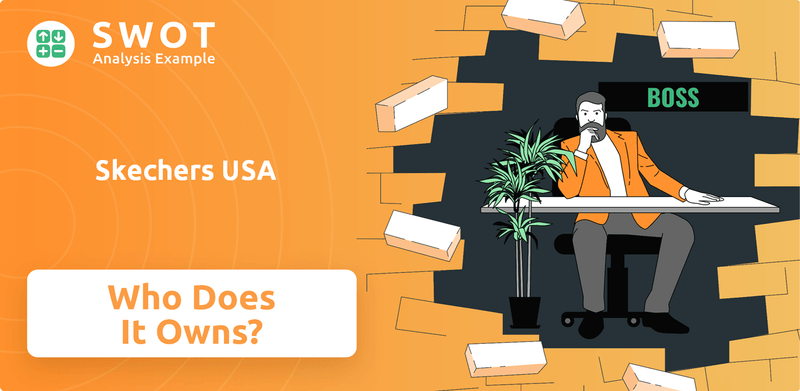
From its humble beginnings in California, the Skechers brand has become a global phenomenon. Knowing who owns Skechers provides critical context for understanding its past, present, and future. This article will explore the Skechers ownership structure, including major shareholders and the influence of the leadership team, to give you a complete picture of this dynamic corporation. We'll delve into questions like: Is Skechers a public company? Who controls Skechers? And what are the implications of its ownership for investors?
Who Founded Skechers USA?
The story of Skechers USA, Inc. begins in 1992 with its founding by Robert Greenberg and his son, Michael Greenberg. Robert, a seasoned veteran of the footwear industry, brought extensive experience from his time at L.A. Gear. Together, they established Skechers with a vision to create a diverse footwear company, focusing on both fashion trends and comfort.
Robert Greenberg, having previously led L.A. Gear, utilized his industry knowledge and entrepreneurial spirit to launch Skechers. The early focus was on building a brand that could adapt to changing consumer preferences in the footwear market. Michael Greenberg joined his father, contributing his own expertise to the venture.
While specific initial equity splits aren't publicly detailed, it's well-understood that the Greenbergs held the foundational and controlling stake in Skechers from the start. This family-led ownership structure was key to guiding the company's early product development and market strategies.
Robert Greenberg and Michael Greenberg founded the company in 1992.
The Greenbergs held the controlling stake, reflecting a family-led ownership.
Funding primarily came from the founders themselves, leveraging their industry connections.
The Greenbergs aimed to create a versatile footwear company, focusing on trends and comfort.
The family's consolidated control was crucial for the company's early direction and growth.
Early agreements like vesting schedules are not extensively disclosed in public records.
The initial backing for the Skechers USA company history came mainly from the founders themselves, leveraging their prior successes and industry connections. The early ownership structure was characterized by the Greenberg family's close control, which allowed them to guide the company's initial product development and market entry strategies. As of 2024, Robert Greenberg remains the CEO, highlighting the sustained family leadership. The company has shown consistent revenue growth, with net sales reaching approximately $7.49 billion in 2023, demonstrating the impact of the founding vision and leadership.
Key aspects of Skechers' founding and early ownership include:
- Founded in 1992 by Robert and Michael Greenberg.
- Greenberg family held the controlling stake.
- Early funding primarily from the founders.
- Focused on diversified footwear, trends, and comfort.
- Family leadership has been sustained over the years.
Skechers USA SWOT Analysis
- Complete SWOT Breakdown
- Fully Customizable
- Editable in Excel & Word
- Professional Formatting
- Investor-Ready Format
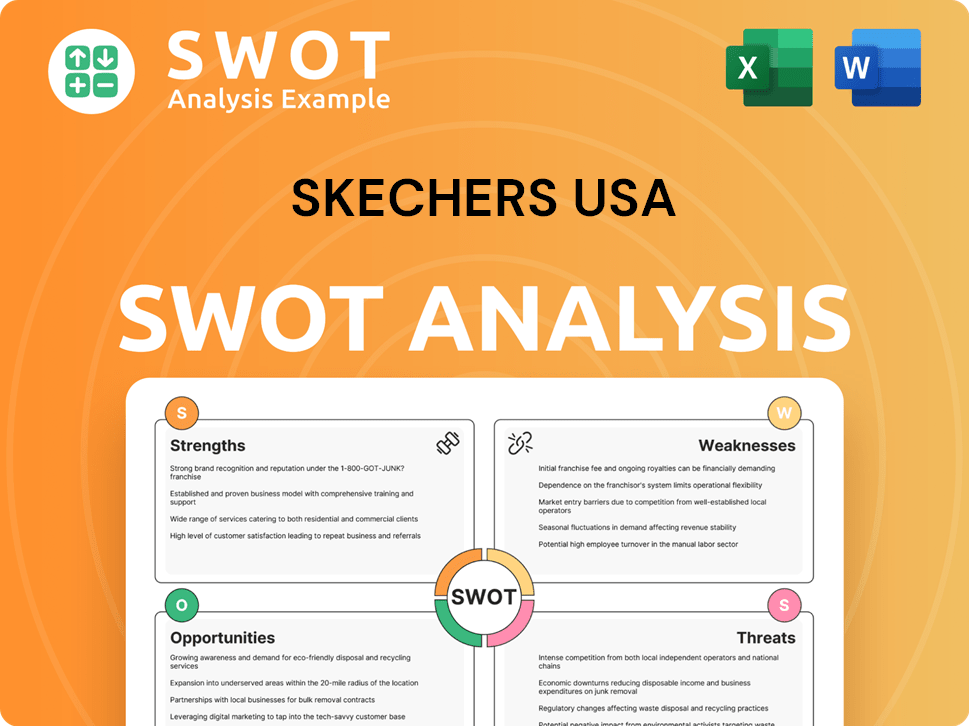
How Has Skechers USA’s Ownership Changed Over Time?
The journey of Skechers USA, Inc. from a private entity to a publicly traded company on June 10, 1999, marked a pivotal moment in its ownership history. This Initial Public Offering (IPO) facilitated broader ownership and access to capital markets for the Skechers company. While the exact initial market capitalization isn't readily available, the IPO significantly altered the company's ownership structure, paving the way for institutional and individual investor participation.
Since its IPO, the Skechers ownership structure has evolved, reflecting the dynamics of the stock market. The Skechers brand has attracted a diverse group of shareholders, including institutional investors, mutual funds, and individual insiders. This shift highlights the company's growth and its integration into the broader financial landscape. Understanding the Skechers ownership structure is crucial for investors and stakeholders alike, as it provides insights into the company's governance and strategic direction.
| Event | Impact on Ownership | Date |
|---|---|---|
| Initial Public Offering (IPO) | Transition from private to public ownership, enabling broader investment. | June 10, 1999 |
| Institutional Investment | Increased ownership by large firms, influencing company strategy and governance. | Ongoing |
| Greenberg Family's Continued Involvement | Maintained significant control and influence through direct ownership. | Ongoing |
As of early 2025, the major shareholders of Skechers USA include Capital Research Global Investors, The Vanguard Group, BlackRock, Inc., and State Street Global Advisors. For example, as of March 31, 2025, Vanguard Group Inc. held 11.23% of shares outstanding, and BlackRock Inc. held 9.87%. Robert Greenberg, the Chairman and CEO, and Michael Greenberg, the President, along with their family, remain significant individual shareholders. Their continued involvement as the Skechers owner underscores the founder-led nature of the business. Changes in ownership, especially the entry and exit of major institutional investors, can affect company strategy and governance. For more information on how the company operates, check out the Revenue Streams & Business Model of Skechers USA article.
Skechers USA, a public company since 1999, has a dynamic ownership structure involving institutional investors and the Greenberg family.
- Institutional investors like Vanguard and BlackRock hold significant shares.
- The Greenberg family maintains substantial control.
- Understanding the ownership structure is crucial for investors.
- The IPO marked a significant shift in ownership.
Skechers USA PESTLE Analysis
- Covers All 6 PESTLE Categories
- No Research Needed – Save Hours of Work
- Built by Experts, Trusted by Consultants
- Instant Download, Ready to Use
- 100% Editable, Fully Customizable
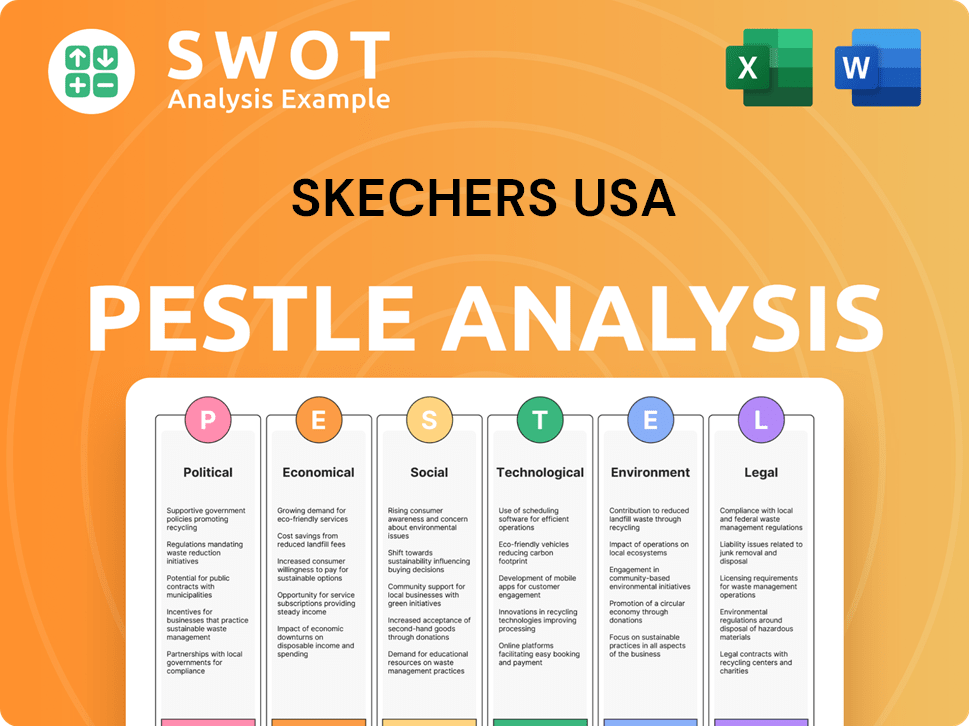
Who Sits on Skechers USA’s Board?
The Board of Directors of Skechers USA, Inc. oversees the company's strategic direction and governance. As of early 2025, the board includes Robert Greenberg as Chairman and CEO, and Michael Greenberg as President and Chief Operating Officer. These key figures represent the founding family and major shareholders. The board also includes independent directors, bringing expertise in areas like finance and retail. The presence of independent directors is critical for ensuring impartial oversight and adherence to corporate governance best practices. The Growth Strategy of Skechers USA has been a key factor in shaping the board's decisions.
The board's composition and the voting structure are regularly disclosed in the company's annual proxy statements, providing transparency on who holds ultimate control and how decisions are shaped within the company. The dual-class share structure grants the Greenberg family disproportionate voting control, allowing them to maintain strategic direction and control over key decisions despite potentially holding a minority of the total equity. This arrangement is common among founder-led companies seeking to preserve long-term vision and resist hostile takeovers. The dual-class structure is a key element of the Skechers ownership structure.
| Board Member | Title | Key Role |
|---|---|---|
| Robert Greenberg | Chairman & CEO | Strategic Leadership and Oversight |
| Michael Greenberg | President & COO | Operational Management and Execution |
| Independent Directors | Various | Objective Oversight and Expertise |
Skechers operates with a dual-class share structure, which significantly impacts voting power. This structure typically involves two classes of common stock: Class A shares, which are publicly traded and generally carry one vote per share, and Class B shares, which are primarily held by the founders and their families, and carry multiple votes per share. This structure allows the founders to maintain control. The dual-class share structure is a significant factor in understanding who controls Skechers. The company's financial information, including details on stock ownership, is available in its public filings.
The Greenberg family, through their Class B shares, maintains significant control over Skechers. This structure helps preserve the company's long-term vision. Skechers is a public company, but the founders retain substantial influence.
- Dual-class share structure
- Founder-led company
- Significant family voting power
- Publicly traded on the New York Stock Exchange (NYSE: SKX)
Skechers USA Business Model Canvas
- Complete 9-Block Business Model Canvas
- Effortlessly Communicate Your Business Strategy
- Investor-Ready BMC Format
- 100% Editable and Customizable
- Clear and Structured Layout
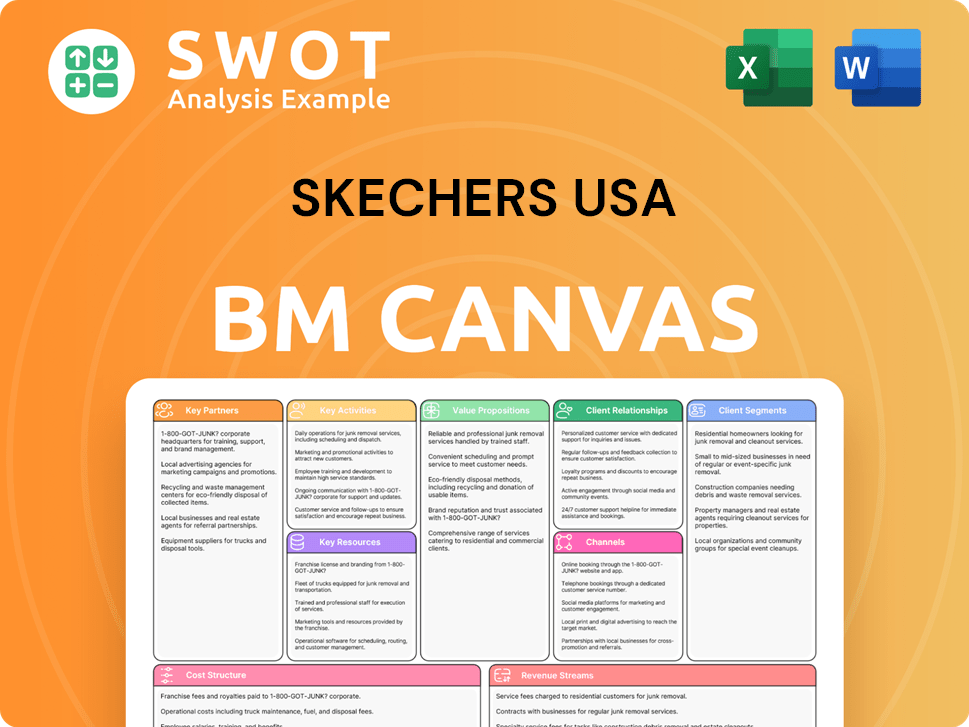
What Recent Changes Have Shaped Skechers USA’s Ownership Landscape?
Over the past few years (roughly 2022-2025), the ownership of Skechers USA, Inc. has shown a consistent pattern. The company, which is publicly traded, has experienced typical shifts in institutional holdings. However, there haven't been any major share buybacks or secondary offerings that have drastically altered the overall ownership percentages. This stability reflects the company's steady performance and growth, which has attracted continued institutional investment. The leadership, with Robert Greenberg and Michael Greenberg at the helm, remains unchanged, reinforcing the founder-led nature of the company. This information is crucial for understanding who owns Skechers and the dynamics of the Skechers company.
Industry trends, such as increased institutional ownership, are evident in Skechers' shareholder base. Large asset managers like Vanguard and BlackRock hold significant stakes. However, the dual-class share structure means that increased institutional ownership doesn't necessarily translate to a proportional increase in voting power. The Greenberg family's Class B shares maintain considerable control. Furthermore, the consolidation within the footwear industry through mergers and acquisitions hasn't directly impacted Skechers' ownership structure recently. Skechers has largely pursued organic growth and strategic partnerships, avoiding large-scale acquisitions that would significantly alter its equity base. If you're interested in further understanding the competitive environment, consider exploring the Competitors Landscape of Skechers USA.
| Shareholder | Approximate % Ownership (as of Latest Filing) | Notes |
|---|---|---|
| Robert Greenberg | ~14% (Class B shares) | Founder and CEO |
| Michael Greenberg | ~14% (Class B shares) | President |
| Vanguard Group | ~9% | Institutional Investor |
| BlackRock | ~7% | Institutional Investor |
The Greenberg family continues to hold substantial control through Class B shares. Institutional investors like Vanguard and BlackRock are major shareholders. There haven't been significant changes in ownership structure recently. This stability is a key aspect of the Skechers ownership structure.
Institutional investors hold a significant portion of Skechers stock. Their influence is present, but the dual-class structure limits their voting power. The company's consistent performance has attracted continued institutional investment. This is relevant when considering who owns Skechers.
Robert and Michael Greenberg remain at the helm of Skechers. This continuity reinforces the founder-led nature of the company. There are no immediate plans for significant ownership changes. The leadership team continues to drive the Skechers brand.
No public statements suggest imminent major shifts in ownership. The current ownership model appears stable, allowing for a long-term strategic focus. Analysts continue to monitor financial performance and market position. The future of the Skechers corporation looks steady.
Skechers USA Porter's Five Forces Analysis
- Covers All 5 Competitive Forces in Detail
- Structured for Consultants, Students, and Founders
- 100% Editable in Microsoft Word & Excel
- Instant Digital Download – Use Immediately
- Compatible with Mac & PC – Fully Unlocked
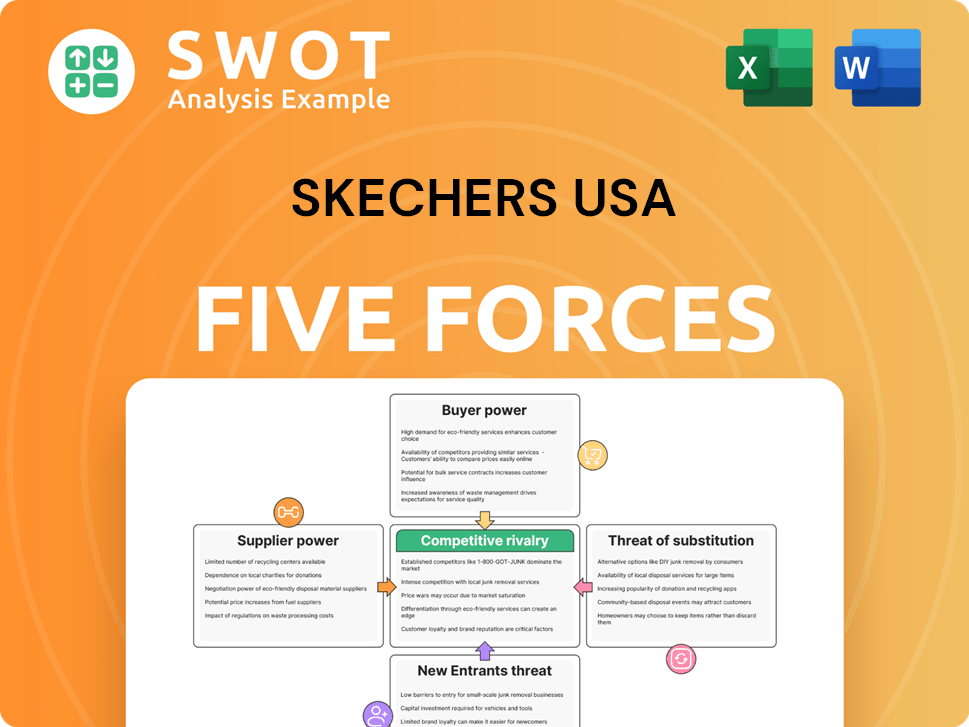
Related Blogs
- What are Mission Vision & Core Values of Skechers USA Company?
- What is Competitive Landscape of Skechers USA Company?
- What is Growth Strategy and Future Prospects of Skechers USA Company?
- How Does Skechers USA Company Work?
- What is Sales and Marketing Strategy of Skechers USA Company?
- What is Brief History of Skechers USA Company?
- What is Customer Demographics and Target Market of Skechers USA Company?
Disclaimer
All information, articles, and product details provided on this website are for general informational and educational purposes only. We do not claim any ownership over, nor do we intend to infringe upon, any trademarks, copyrights, logos, brand names, or other intellectual property mentioned or depicted on this site. Such intellectual property remains the property of its respective owners, and any references here are made solely for identification or informational purposes, without implying any affiliation, endorsement, or partnership.
We make no representations or warranties, express or implied, regarding the accuracy, completeness, or suitability of any content or products presented. Nothing on this website should be construed as legal, tax, investment, financial, medical, or other professional advice. In addition, no part of this site—including articles or product references—constitutes a solicitation, recommendation, endorsement, advertisement, or offer to buy or sell any securities, franchises, or other financial instruments, particularly in jurisdictions where such activity would be unlawful.
All content is of a general nature and may not address the specific circumstances of any individual or entity. It is not a substitute for professional advice or services. Any actions you take based on the information provided here are strictly at your own risk. You accept full responsibility for any decisions or outcomes arising from your use of this website and agree to release us from any liability in connection with your use of, or reliance upon, the content or products found herein.